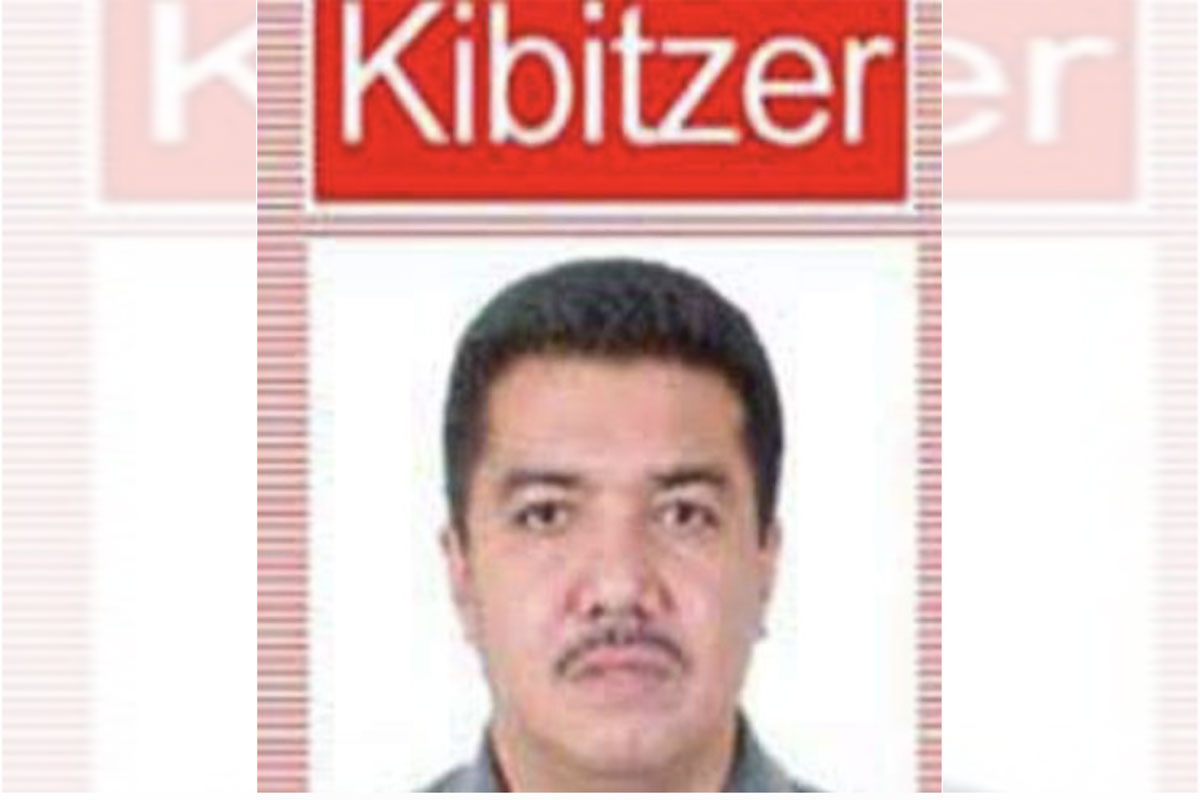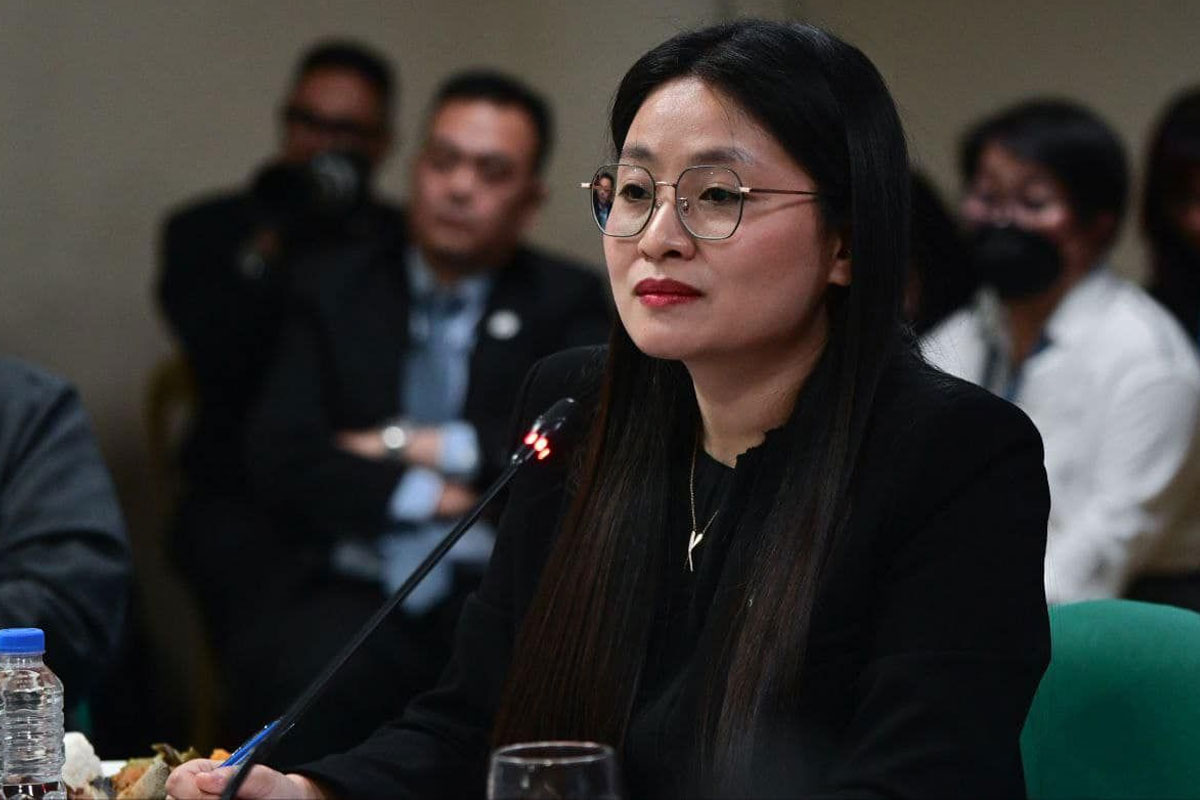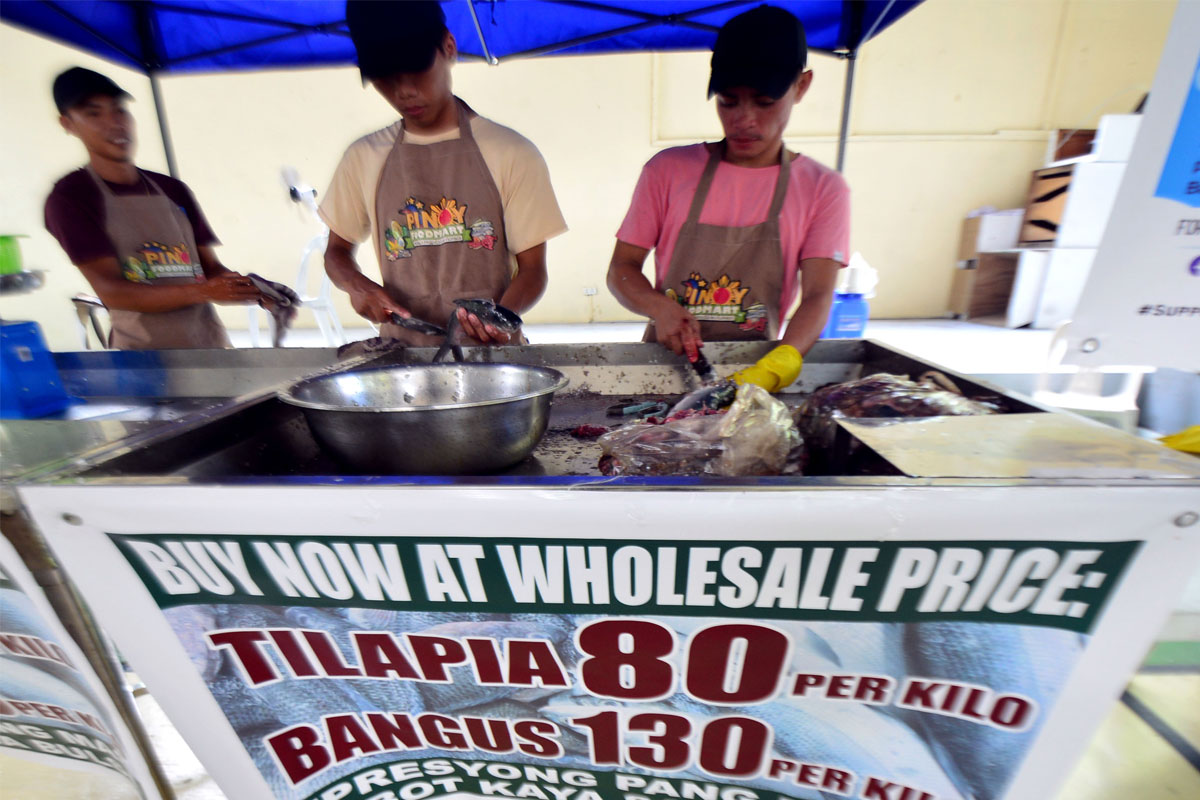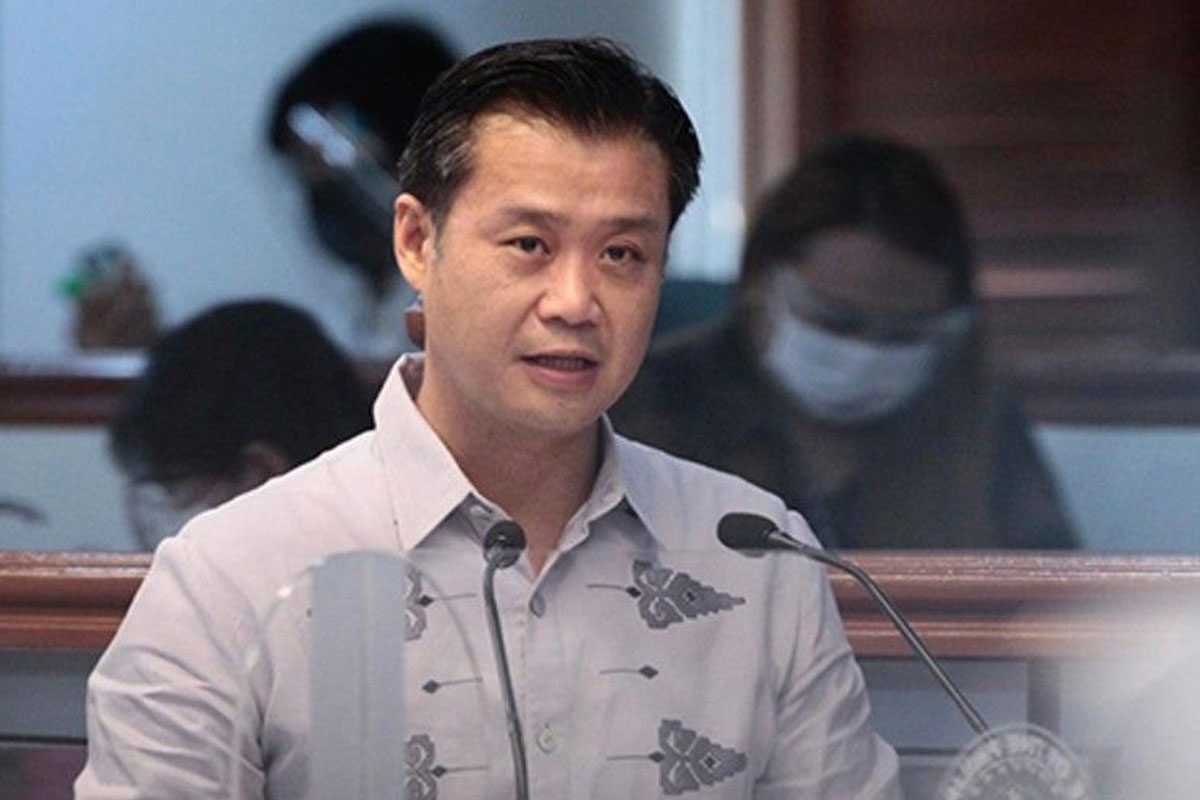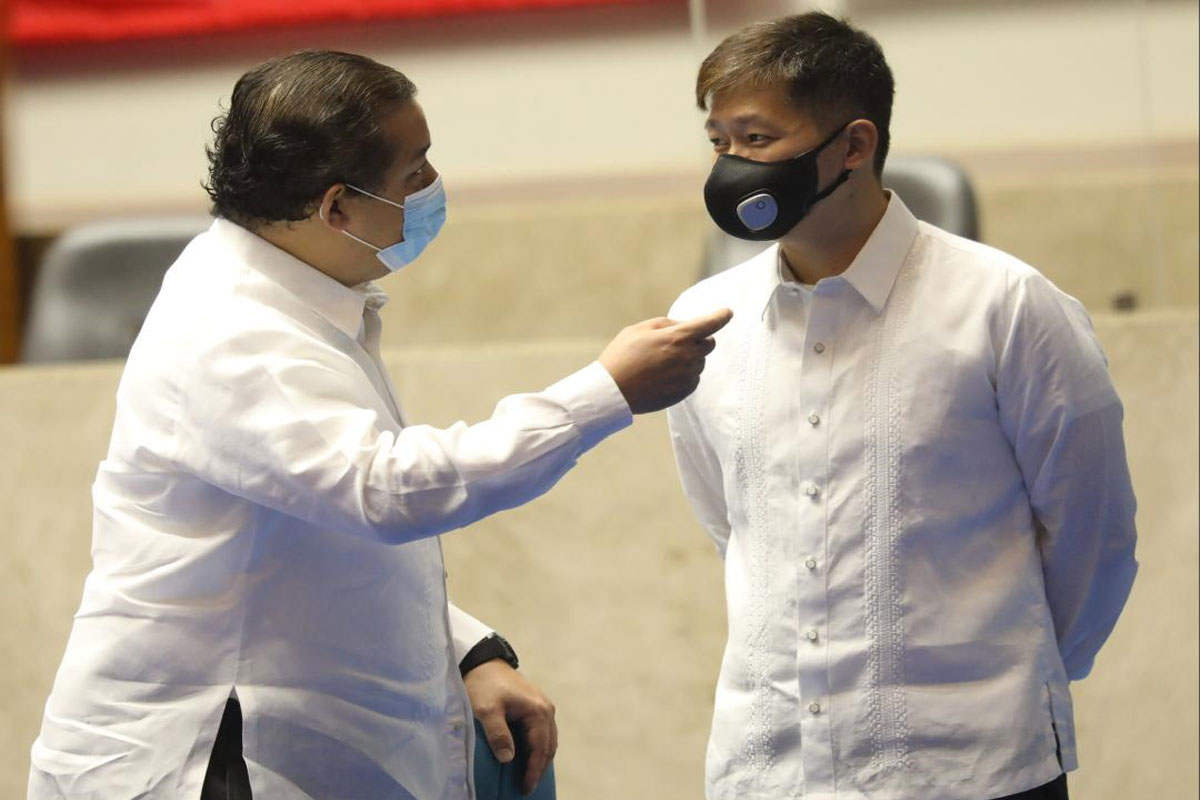 BUDGET BRIEFINGS — House Majority Leader and Leyte Rep. Martin Romualdez (left) discusses fund matters with Committee on Appropriations Chairman Rep. Eric Go Yap (right) at the plenary hall during the Development Budget Coordination Committee briefing for the 2022 national budget. The committee is set to discuss the budgets for the Department of Budget and Management (DBM), National Economic and Development Authority (NEDA), Department of Finance (DOF) and Bangko Sentral ng Pilipinas (BSP). Photo by VER NOVENO
BUDGET BRIEFINGS — House Majority Leader and Leyte Rep. Martin Romualdez (left) discusses fund matters with Committee on Appropriations Chairman Rep. Eric Go Yap (right) at the plenary hall during the Development Budget Coordination Committee briefing for the 2022 national budget. The committee is set to discuss the budgets for the Department of Budget and Management (DBM), National Economic and Development Authority (NEDA), Department of Finance (DOF) and Bangko Sentral ng Pilipinas (BSP). Photo by VER NOVENO
Romualdez: House to prioritize PH interests in budget deliberations
HOUSE Majority Leader and Leyte 1st District Rep. Martin G. Romualdez on Thursday assured that the House of representatives will uphold the country’s interests and survival from the coronavirus disease 2019 (COVID-19) pandemic in the ongoing deliberations of the P5.024 trillion national budget for next year.
“Rest assured that during the congressional review, our people’s interest in these challenging times will be our primordial concern,” Romualdez, chairman of the House committee on rules, said after attending the first budget briefing by the House committee on appropriations led by ACT-CIS party-list Rep. Eric Yap. “This, I believe, will help our common efforts to sustain our COVID-19 response efforts while supporting the gradual transition to full recovery.”
During the first day of the budget hearing, the Yap panel focused on the macroeconomic assumptions of the Development Budget Coordination Committee (DBCC)—composed of the Department of Budget and Management (DBM), Department of Finance (DOF), National Economic and Development Authority (NEDA), and the Bangko Sentral ng Pilipinas (BSP) on 2022 national budget.
Some attendees in the hybrid budget deliberations were Finance Sec. Carlos Dominguez III, NEDA Secretary Karl Kendrick Chua, BSP Governor Benjamin Diokno, and Budget officer-in-charge Usec. Tina Canda. “Today (Thursday) we will be deliberating the macroeconomic assumptions adopted and approved by the Development Budget Coordination Committee or DBCC to arrive at the P5.024 trillion budget,” Yap said. “We shall determine the viability of the proposed revenue program, the borrowing, and financing requirements to finance the proposed expenditure program. We shall also determine the prioritization adopted in allocating our financial resources for the fiscal year 2022 budget amid the continuing threat of this global pandemic.”
Romualdez, president of the Lakas-Christian Muslim Democrats (CMD), also appealed to his colleagues to scrutinize the National Expenditure Program (NEP) designed to push the Philippines’ gradual transition to full recovery status from pandemic.
“This, I believe, will help our common efforts to sustain our COVID-19 response efforts while supporting the gradual transition to full recovery.
It is now the duty of your representatives to review the proposed budget to ensure that the people’s taxes will be spent fairly and equitably among regions,” Romualdez, a lawyer from the University of the Philippines (UP) and president of the Philippine Constitution Association (Philconsa).
Yap also appealed to his colleagues for the swift passage of the national budget.
“Twelve months ago, when we deliberated the 2021 national budget, we were dealing with the effects of the pandemic, and yet the virus persists up to this day and is more threatening with the emergence of new variants,” Yap said who earlier said that the national budget will be passed by the House of Representatives on second reading on September 30.
“But we will not be deterred by the threat of this unseen enemy, COVID-19, from performing our solemn duties to our country and our people to provide an effective pandemic response through this budget. We must act swiftly, efficiently, effectively to win the fight against COVID-19 in the coming years,” Yap said.
ECONOMY TO RECOVER AT THE EARLIEST BY END OF 2022
During the budget deliberations, Socioeconomic Planning Secretary and NEDA chief Karl Kendrick Chua said they expect the economy to recover at the earliest by the end of next year, adding the recovery prospects this year remains positive.
“This will allow us to recover to pre-pandemic levels some time at the end of 2022, if not early 2023,” Chua told the Yap panel. “This will also help prevent long-term scarring and productivity losses.”
With improving collections mainly through digitalization, Dominguez for his part said “we expect to recover our pre-pandemic revenue levels in 2022.”
“To achieve a solid recovery, we need to ensure that fiscal responsibility is constantly observed. The Executive and the Legislature must work together to fight the pandemic sustainably by keeping our deficit and debt ratios within reasonable levels, so that we can leave our finances in great shape for the next administration and the future generations of Filipinos. Fiscal discipline will save us from this long battle against the pandemic,” Dominguez said.
“By our projections, we will be collecting 3.3 trillion pesos next year. This is equivalent to 15 percent of GDP. The estimate is 14 percent higher than the 2021 revenue collection program of 2.9 trillion pesos, or 14.5 percent of GDP. Revenues will continue to grow from 2022 onwards, reaching 4 trillion pesos in 2024,” Dominguez said.
“Our tax collection is projected to reach 3.1 trillion pesos next year, equivalent to 14.2 percent of GDP. This is significantly higher than the programmed 2.7 trillion pesos for 2021, equivalent to 13.7 percent of GDP. Tax collections will be on an upward trend starting next year, reaching 3.8 trillion pesos by 2024,” Dominguez said.
From 2022 onwards, Dominguez said the country’s expected revenues will exceed the expenditure growth.
“We estimate the budget deficit to decrease to 7.5 percent of GDP next year, from the 9.3 percent of GDP projection for 2021. The medium-term fiscal program will follow a declining deficit path. By 2024, our deficit-to-GDP ratio will settle at 4.9 percent. Total gross borrowings for 2022 are programmed to drop to 2.5 trillion pesos from about 3 trillion pesos expected this year. These borrowings will support both our public health response and the economic investments needed to spur growth. Following the pattern set the past few years, the bulk of the borrowings will be sourced locally,” Dominguez said.
“Although we have acquired additional debt to meet the health emergency, public borrowing remains well within sustainable levels. The national government debt-to-GDP ratio is projected to slightly increase to 60 percent in 2022 from the programmed 59 percent ratio in 2021. Our debt ratio will start its downward trend from 2023 onwards,” he said.
“I would like to emphasize again that the increase in our debt level is only temporary. It did not stem from profligate public spending but rather resulted from a universal shock that deteriorated the financial positions of almost all countries around the world. The principal contributors to the increase in our debt are the weakening of the economy and lower revenue collections due to the lockdowns. Both of which are expected to recover quickly as soon as the infections are contained,” Dominguez added.




